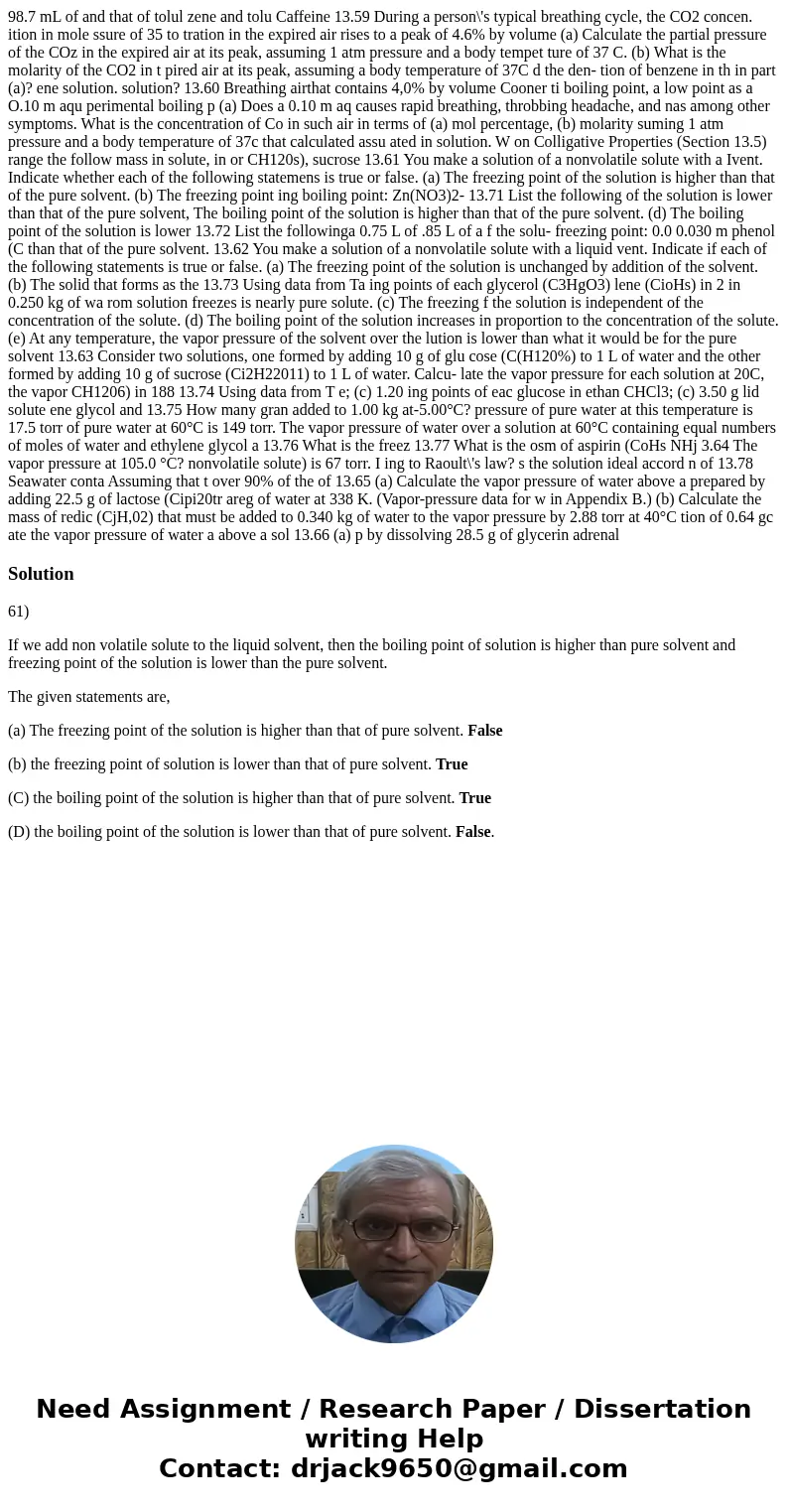987 mL of and that of tolul zene and tolu Caffeine 1359 Duri
98.7 mL of and that of tolul zene and tolu Caffeine 13.59 During a person\'s typical breathing cycle, the CO2 concen. ition in mole ssure of 35 to tration in the expired air rises to a peak of 4.6% by volume (a) Calculate the partial pressure of the COz in the expired air at its peak, assuming 1 atm pressure and a body tempet ture of 37 C. (b) What is the molarity of the CO2 in t pired air at its peak, assuming a body temperature of 37C d the den- tion of benzene in th in part (a)? ene solution. solution? 13.60 Breathing airthat contains 4,0% by volume Cooner ti boiling point, a low point as a O.10 m aqu perimental boiling p (a) Does a 0.10 m aq causes rapid breathing, throbbing headache, and nas among other symptoms. What is the concentration of Co in such air in terms of (a) mol percentage, (b) molarity suming 1 atm pressure and a body temperature of 37c that calculated assu ated in solution. W on Colligative Properties (Section 13.5) range the follow mass in solute, in or CH120s), sucrose 13.61 You make a solution of a nonvolatile solute with a Ivent. Indicate whether each of the following statemens is true or false. (a) The freezing point of the solution is higher than that of the pure solvent. (b) The freezing point ing boiling point: Zn(NO3)2- 13.71 List the following of the solution is lower than that of the pure solvent, The boiling point of the solution is higher than that of the pure solvent. (d) The boiling point of the solution is lower 13.72 List the followinga 0.75 L of .85 L of a f the solu- freezing point: 0.0 0.030 m phenol (C than that of the pure solvent. 13.62 You make a solution of a nonvolatile solute with a liquid vent. Indicate if each of the following statements is true or false. (a) The freezing point of the solution is unchanged by addition of the solvent. (b) The solid that forms as the 13.73 Using data from Ta ing points of each glycerol (C3HgO3) lene (CioHs) in 2 in 0.250 kg of wa rom solution freezes is nearly pure solute. (c) The freezing f the solution is independent of the concentration of the solute. (d) The boiling point of the solution increases in proportion to the concentration of the solute. (e) At any temperature, the vapor pressure of the solvent over the lution is lower than what it would be for the pure solvent 13.63 Consider two solutions, one formed by adding 10 g of glu cose (C(H120%) to 1 L of water and the other formed by adding 10 g of sucrose (Ci2H22011) to 1 L of water. Calcu- late the vapor pressure for each solution at 20C, the vapor CH1206) in 188 13.74 Using data from T e; (c) 1.20 ing points of eac glucose in ethan CHCl3; (c) 3.50 g lid solute ene glycol and 13.75 How many gran added to 1.00 kg at-5.00°C? pressure of pure water at this temperature is 17.5 torr of pure water at 60°C is 149 torr. The vapor pressure of water over a solution at 60°C containing equal numbers of moles of water and ethylene glycol a 13.76 What is the freez 13.77 What is the osm of aspirin (CoHs NHj 3.64 The vapor pressure at 105.0 °C? nonvolatile solute) is 67 torr. I ing to Raoult\'s law? s the solution ideal accord n of 13.78 Seawater conta Assuming that t over 90% of the of 13.65 (a) Calculate the vapor pressure of water above a prepared by adding 22.5 g of lactose (Cipi20tr areg of water at 338 K. (Vapor-pressure data for w in Appendix B.) (b) Calculate the mass of redic (CjH,02) that must be added to 0.340 kg of water to the vapor pressure by 2.88 torr at 40°C tion of 0.64 gc ate the vapor pressure of water a above a sol 13.66 (a) p by dissolving 28.5 g of glycerin adrenal 
Solution
61)
If we add non volatile solute to the liquid solvent, then the boiling point of solution is higher than pure solvent and freezing point of the solution is lower than the pure solvent.
The given statements are,
(a) The freezing point of the solution is higher than that of pure solvent. False
(b) the freezing point of solution is lower than that of pure solvent. True
(C) the boiling point of the solution is higher than that of pure solvent. True
(D) the boiling point of the solution is lower than that of pure solvent. False.

 Homework Sourse
Homework Sourse